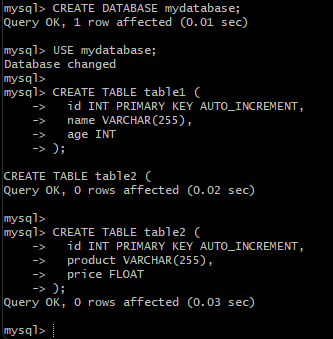Module 9 - Assignment
Problem Statement: You work for xyz organization. Your job work is to manage Linux-based servers.
You have been asked to:
- Install MySQL on CentOS
- Create a database with two tables - table1 & table2
- Create a shell script which can be used to insert 4 rows of data into table1 & table2
Update packages:
sudo yum update -yInstall mysql:
sudo yum install mysql-server -yStart the service and confirm it is up
sudo systemctl start mysqld
sudo systemctl status mysqld
Run mysql_secure_installation for security-related operations like configuring a password
sudo mysql_secure_installationLog in to the MySQL shell as the root user: mysql -u root -p using previously configured password

Step 1: Create a Database
CREATE DATABASE mydatabase;Step 2: Create Tables
USE mydatabase;
CREATE TABLE table1 (
id INT PRIMARY KEY AUTO_INCREMENT,
name VARCHAR(255),
age INT
);
CREATE TABLE table2 (
id INT PRIMARY KEY AUTO_INCREMENT,
product VARCHAR(255),
price FLOAT
);
3. Create a Shell Script for Inserting Data:
Created script named mysql_script.sh with the following content using vi:
#!/bin/bash
# Log in to the MySQL server and insert data into table1 and table2
mysql -u root -p -D 'mydatabase' <<EOF
INSERT INTO table1 (name, age) VALUES ('Alice', 30);
INSERT INTO table1 (name, age) VALUES ('Bob', 40);
INSERT INTO table1 (name, age) VALUES ('Charlie', 50);
INSERT INTO table1 (name, age) VALUES ('Dave', 60);
INSERT INTO table2 (product, price) VALUES ('Laptop', 1000);
INSERT INTO table2 (product, price) VALUES ('Phone', 500);
INSERT INTO table2 (product, price) VALUES ('TV', 1500);
INSERT INTO table2 (product, price) VALUES ('Camera', 800);
EOFGiving script execution permissions:
chmod +x insert_data.sh
Executing the script:
./insert_data.shPrompts for password

Confirming input:
- Logging to MySQL shell as the root user:
mysql -u root -pprompted for password
- Switch to database:
USE mydatabase;- Checking data in
table1:
SELECT * FROM table1;- Checking data in
table2:
SELECT * FROM table2;